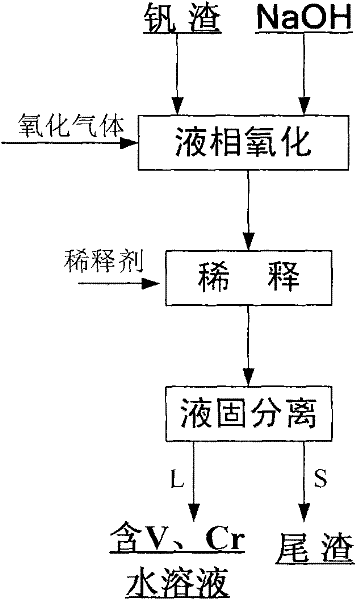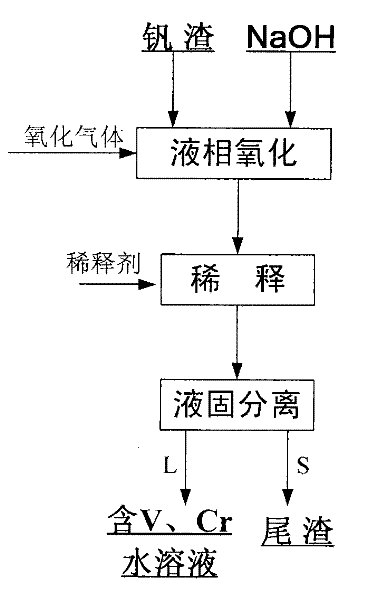Method for decomposing chromium-containing vanadium slag by using sodium hydroxide molten salt
A technology of sodium hydroxide and molten salt, applied in the direction of improving process efficiency, etc., can solve the problems of chlorine-containing gas polluting the environment, low recovery rate of vanadium, and non-recyclable chromium, etc., and achieve the effect of high resource utilization rate
- Summary
- Abstract
- Description
- Claims
- Application Information
AI Technical Summary
Problems solved by technology
Method used
Image
Examples
Embodiment 1
[0027] This embodiment uses vanadium slag containing V 2 o 5 7.3wt%, Cr 2 o 3 3.6wt%, vanadium-titanium magnetite is produced by the blast furnace process to contain vanadium (chromium) pig iron (water), and then the vanadium slag formed by the process of vanadium extraction with air as the oxidation medium under high temperature conditions.
[0028] 1) First weigh the material: according to the mass ratio of the amount of sodium hydroxide to the vanadium slag is 2.5: 1, weigh a certain amount of NaOH and vanadium slag; that is, weigh 125g of NaOH and 50g of vanadium slag;
[0029] 2) Liquid-phase oxidation reaction: put the NaOH weighed in step 1) into the normal pressure reactor, set the temperature of the reactor to 500°C, and start to heat up; rise to 500°C, and then add the vanadium slag taken into the In NaOH molten salt, then feed air, the air flow rate is controlled at 1L / min, the reaction time is 6h, and the reaction slurry is obtained after the reaction;
[0030]...
Embodiment 2
[0033] This embodiment uses vanadium slag containing V 2 o 5 10.2wt%, Cr 2 o 3 4.0wt%, is the vanadium (chromium)-containing pig iron (water) produced by the direct reduction process of vanadium-titanium magnetite, and then the vanadium slag formed by the process of extracting vanadium from molten iron under high temperature conditions with oxygen as the oxidation medium.
[0034] 1) First weigh the material: according to the mass ratio of the amount of sodium hydroxide to the vanadium slag is 6: 1, weigh a certain amount of NaOH and vanadium slag; that is, weigh 600g of NaOH and 100g of vanadium slag;
[0035] 2) Liquid-phase oxidation reaction: put the NaOH weighed in step 1) into the normal-pressure reactor, set the temperature of the reactor to 600°C, and start to heat up; rise to 600°C, and then add the vanadium slag taken into the In NaOH molten salt, then feed oxygen, the flow rate of oxygen is controlled at 0.2L / min, the reaction time is 0.5h, and the reaction slurr...
Embodiment 3
[0039] This embodiment uses vanadium slag containing V 2 o 5 9.8wt%, Cr 2 o 3 10.2wt%, vanadium-titanium magnetite is produced by blast furnace process to contain vanadium (chromium) pig iron (water), and then the vanadium slag formed by the process of extracting vanadium by top-blown combined-blown converter with air as the oxidation medium under high temperature conditions.
[0040] 1) First weigh the material: according to the mass ratio of the amount of sodium hydroxide to the vanadium slag is 3: 1, take a certain amount of NaOH and vanadium slag; promptly weigh 750g of NaOH and 250g of vanadium slag;
[0041] 2) Liquid-phase oxidation reaction: put the NaOH weighed in step 1) into the normal-pressure reactor, set the temperature of the reactor to 550°C, and start to heat up; rise to 550°C, and then add the vanadium slag taken into the In NaOH molten salt, then pass into the mixed gas of air and oxygen, the air:oxygen volume ratio is 1:4, the gas flow rate is controlled...
PUM
 Login to View More
Login to View More Abstract
Description
Claims
Application Information
 Login to View More
Login to View More - R&D
- Intellectual Property
- Life Sciences
- Materials
- Tech Scout
- Unparalleled Data Quality
- Higher Quality Content
- 60% Fewer Hallucinations
Browse by: Latest US Patents, China's latest patents, Technical Efficacy Thesaurus, Application Domain, Technology Topic, Popular Technical Reports.
© 2025 PatSnap. All rights reserved.Legal|Privacy policy|Modern Slavery Act Transparency Statement|Sitemap|About US| Contact US: help@patsnap.com


